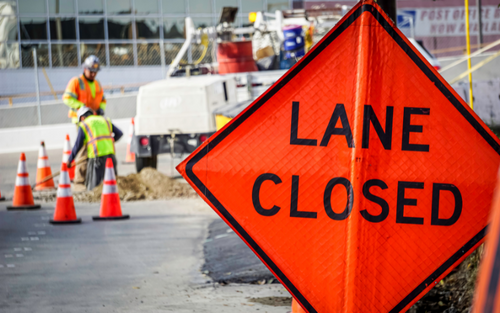Work Zone Awareness Week is April 17-21, 2023
National Work Zone Awareness Week (NWZAW) is an annual spring campaign held at the start of construction season. It aims to prevent accidents and injuries caused by motor vehicles operating in highway work zones through safe driving. It is scheduled to run from April 17 to 21 and will be celebrated nationwide at worksites and construction management offices. The aim is to prevent accidents and injuries caused by motor vehicles operating in active work zones. Private companies and individuals are encouraged to participate in activities during the week. Your company or organization can also host your own work zone safety event by contacting the NWZAW and submitting a proposal.
Workers need access to a safe environment to do their jobs, and the drivers and operators of construction vehicles need to use caution in work zones to prevent accidents and injuries. Learn more about National Work Zone Awareness Week and how you can play a role in work zone safety.
What is Work Zone Awareness Week?
The week-long event was created in partnership with the U.S. Department of Transportation (DOT) and is overseen by various state and local government agencies and departments responsible for maintaining transportation safety. It is a joint effort between private and public organizations designed to promote awareness of work zone transportation safety among those who work in the construction industry. Events providing important work zone safety information will be held weekly at private and public facilities. Organizations will also spread the word online and on social media to increase awareness.
Congestion is a significant cause of work zone accidents and injuries. According to the National Highway Traffic Safety Administration (NHTSA), there were 156 pedestrian fatalities in active work zones in 2020 alone, 244 fatal crashes involving commercial vehicles, 857 total work zone fatalities, an estimated 44,000 work zone injuries, and 102,000 estimated work zone crashes. The NHTSA says work zones account for 10% of all roadway congestion. This cost amounts to $4.6 billion in delay costs and approximately 1.75 billion hours of vehicle delays.
Construction companies and workers can do more to limit the number of injuries and fatalities in active work zones by taking steps to protect their teams from harm.
How to Increase Work Zone Safety
It all starts with a proper safety assessment of the work zone, including the potential hazards that can pose a risk to employees. Operating a motor vehicle in an active work zone can be extremely dangerous. Managers and workers should identify possible congestion points and look for ways to decrease the potential for accidents and collisions.
Focus on increasing illumination in the work zone to ensure drivers can see their surroundings when operating a motor vehicle. The vehicle should also have limited access to the work zone and only be allowed to occupy certain areas. The team should also put up signs marking the active roadway so that workers can maintain a safe distance. Workers should be trained to reduce their speed when driving in a work zone. Driving at fast speeds increases the risk of workplace accidents and injuries. Posting speed limit signs will remind them to slow down.
Workers occupying the space on foot should wear high visibility clothing, including neon orange hi-vis safety vests, jackets, and pants. Reflective tape is also required for those occupying active roadways. They should alert one another when a vehicle enters or drives through the work zone so everyone can move to a designated area. The alert can come over the radio or by sounding an alarm. Additional traffic safety equipment may be used for different work zones.
Everyone occupying the space should look out for one another and raise their concerns if they see something unsafe. Individuals should stay with other workers or in high-visibility areas to avoid coming in contact with the vehicle. They should also make eye contact with the vehicle operator to increase their chances of being seen.
Workers operating motor vehicles should remember to avoid backing up whenever possible by parking in a spot that allows them to drive forward when exiting. Having an exit/entrance on either side of the work zone is helpful so the driver doesn’t have to leave the same way they came in. If the driver needs to reverse, another person should direct them from a safe distance. The driver should also honk their horn or activate an alarm to let others know they are reversing.
The mirrors and lights on the vehicle must be maintained to increase visibility. Drivers must also follow all the road signs and observed rules in the work zone. This begins with proper training and licensing. They must also wear their seat belt and adhere to the designated travel route. If the road becomes unsafe, they should stop and contact their supervisor for more information.
Drivers must stay focused on the roadway when operating the motor vehicle. Nothing should distract them or block their view of the road. It’s best to keep the windows open and to eliminate unnecessary sound, so the driver can hear what other workers are saying.
Everyone can ensure a safe work zone, including companies, managers, and workers. Preventing workplace collisions and accidents takes proper communication, training, and constant coordination. Workers are required to wear the appropriate safety gear and observe the laws of the road to keep each other safe from harm.
Recent Posts
-
Customizing Gas Detectors: Tailoring Solutions to Fit Your Unique Requirements
In today’s diverse industrial landscape, a one-size-fits-all approach to safety simply doesn’t cu …Jul 3rd 2024 -
10 Ways to Prevent Wildfires
You can prevent wildfires by extinguishing flames before you leave the worksite. Avoid practicing …Jul 1st 2024 -
ANSI/ISEA 138 Safety Gloves: Ensuring Hand Protection
The human hand is an anatomical masterpiece and arguably the greatest tool attached to our bodies …Jun 25th 2024





